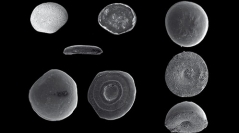

 Geodiversitas
33 (2) - Pages 285-301
Geodiversitas
33 (2) - Pages 285-301We describe a new actinopterygian fauna from the uppermost Cretaceous of Quintanilla la Ojada (Burgos, Spain), in the Villarcayo Sinclynorium of the Basque-Cantabrian Region. It consists mostly of isolated teeth of pycnodontiforms (cf. Anomoeodus sp., Pycnodontoidea indet.), amiiforms (cf. Amiidae indet.) and teleosteans (elopiforms: Phyllodontinae indet., Paralbulinae indet.; aulopiforms: Enchodontidae indet., plus fragmentary fin spines of Acanthomorpha indet.). Paralbulinae teeth are the most abundant elements in the fossil assemblage. All the remains are disarticulated and show intense post-mortem abrasion. The fossil association has been found in dolomite sandstones that are laterally correlated with the Valdenoceda Formation (Lower to basal Upper Maastrichtian) of the Castilian Ramp. The observed taphonomic features are coherent with the sedimentological interpretation of the fossiliferous beds as coastal deltaic deposits.
Osteichthyes, Pycnodontiformes, Amiiformes, Elopiformes, Aulopiformes, Acanthomorpha, Maastrichtian, Iberian Peninsula, Basque-Cantabrian Region